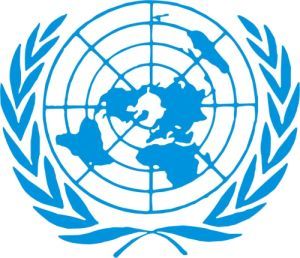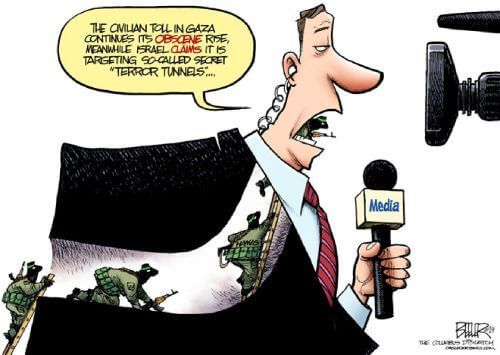![]() 2014 Dishonest Reporter Award: Gaza War Correspondents
2014 Dishonest Reporter Award: Gaza War Correspondents
We asked HonestReporting readers to choose this year’s Dishonest Reporter award, and the consensus “winner” was the New York Times.
There were many valid reasons to go with the popular choice (more on that here).
But the more we considered the saturation coverage of the 50-day conflict, the more we realized that there were issues far bigger than the Times. And with so many instances of bad journalism, singling out one paper or personality didn’t work.
 That’s why we set aside the New York Times.
That’s why we set aside the New York Times.
So what were the main problems with this year’s Gaza war correspondents?
Parachute Journalism
Media reinforcements — freelancers, celebrity journos, roving reporters, and staffers pulled from other bureaus to augment war coverage — outnumbered the foreign reporters regularly based in Israel.
The knock on these “parachute journalists” is that they have little to no background info and limited relationships with sources in the conflict zones they drop into. Israel’s Government Press Office said it serviced 777 foreign reporters dispatched to the region in addition to the approximately 750 accredited foreign journalists already based in the country.
Veteran Jerusalem-based reporter Matthew Kalman‘s criticisms of parachute journalism in the Mideast (months before the conflict) were remarkably prescient:
“Imagine that a Russian speaking reporter lands in Texas and only speaks Russian and proceeds to analyze, commentate and report on American politics; and that’s the situation that we have in the Middle East,” Kalman said.
Indeed, issues like, for example, Jerusalem’s approach to conflict management (“mowing the lawn“), and Hamas’s ultimate goal (destroying Israel, as elaborated by S.E. Cupp) didn’t get significant attention.
Bottom line: Half the reporters covering Protective Edge didn’t understand the conflict.
Media Intimidation
Hamas admitted intimidating reporters. For good reason too.
It wasn’t in Hamas’s interest to let the world see images of rockets launched from civilian areas, armed combatants in civilian clothes, or the schools, mosques, and clinics used to cover tunnels, arms dumps, and sniper nests. A small handful of reporters cried foul at the thuggery and deceit, but they were the exception.
The intimidation related to another issue: the complete absence of any photos or videos of Hamas combatants.
The lack of images of gunmen in the densely populated Strip goes to the heart of the Hamas human shield doctrine, which deliberately raises collateral damage from IDF operations. Hamas counts on the world to condemn Israel as civilian casualties mount.
The most noteworthy footage Hamas didn’t want you to see was when New Delhi’s NDTV filmed a rocket squad setting up a launcher outside a hotel where foreign journalists were staying. Tellingly, the video wasn’t released until the NDTV team was safely back in India.
Palestinian photographers under Hamas rule don’t have the luxury of leaving Gaza. Foreign photographers may have turned a blind eye, or allowed themselves to be swayed by Hamas minders. Perhaps some photographers out there believe a cover up is justified to help the Palestinian cause. That’s one observation raised by former Associated Press correspondent Matti Friedman in a widely read expose in Tablet on media bias:
The fact is that Hamas intimidation is largely beside the point because the actions of Palestinians are beside the point: Most reporters in Gaza believe their job is to document violence directed by Israel at Palestinian civilians. That is the essence of the Israel story. In addition, reporters are under deadline and often at risk, and many don’t speak the language and have only the most tenuous grip on what is going on. They are dependent on Palestinian colleagues and fixers who either fear Hamas, support Hamas, or both. Reporters don’t need Hamas enforcers to shoo them away from facts that muddy the simple story they have been sent to tell.
It is not coincidence that the few journalists who have documented Hamas fighters and rocket launches in civilian areas this summer were generally not, as you might expect, from the large news organizations with big and permanent Gaza operations. They were mostly scrappy, peripheral, and newly arrived players—a Finn, an Indian crew, a few others. These poor souls didn’t get the memo.
Peter Beaumont of The Guardian explained the significance:
In most wars I have covered, you encounter one of the combatant parties, often both, but in Gaza, where death falls from the sky, those fighting are largely invisible except for the impact of their weapons. The result is that you see a war in Gaza through the prism of the suffering of the victims – a conflict in which those willing to offer an organising rationale are absent.
We inquired through contacts if any journalists were willing to release their photos or videos, but none were forthcoming.
Contentious Casualty Counts
 Casualty figures and the breakdown of civilians vs. combatants were based on either Hamas officials or on the UN.
Casualty figures and the breakdown of civilians vs. combatants were based on either Hamas officials or on the UN.
The unfortunate problem with the UN’s numbers was that its stats were based on dubious non-governmental organizations hostile to Israel, such as the Palestinian Center for Human Rights. (Steven Stotsky deconstructed this problem after taking a closer look at the PCHR.)
Yes, independent verification of casualties in the difficult circumstances of Gaza is a daunting task.
But consider this: By abdicating the fact-checking to Palestinian and Israeli groups, journalism devolves from certainty to he said/she said claims of Palestinian and Israeli organizations (for example, the Al Mezan Center for Human Rights and the Meir Amit Intelligence and Information Center). In theory, Big Media should fairly balance each other’s claims. However, the foreign press can’t be relied upon to work that way. In a followup expose in The Atlantic, Matti Friedman explained why Israel’s side of the story won’t get the same treatment:
In my time in the press corps, I learned that our relationship with these [non-governmental organizations] was not journalistic. My colleagues and I did not, that is, seek to analyze or criticize them. For many foreign journalists, these were not targets but sources and friends—fellow members, in a sense, of an informal alliance. This alliance consists of activists and international staffers from the UN and the NGOs; the Western diplomatic corps, particularly in East Jerusalem; and foreign reporters. (There is also a local component, consisting of a small number of Israeli human-rights activists who are themselves largely funded by European governments, and Palestinian staffers from the Palestinian Authority, the NGOs, and the UN.) . . .
In these circles, in my experience, a distaste for Israel has come to be something between an acceptable prejudice and a prerequisite for entry. I don’t mean a critical approach to Israeli policies or to the ham-fisted government currently in charge in this country, but a belief that to some extent the Jews of Israel are a symbol of the world’s ills, particularly those connected to nationalism, militarism, colonialism, and racism . . .
Which leads us to . . .
Casualty Figures As a Moral Barometer
Time and again, we saw infographics, editorials, headlines, and simple throwaway lines repeating the idea that Palestinian civilians were bearing the brunt of the casualties. In turn, Big Media judged Israel as either bloodthirsty or incompetent. Channel 4’s Jon Snow accused Israel of both while interviewing Israeli spokesman Mark Regev.
In essence, the casualty count became a phony moral barometer, which was later debunked by the likes of Col. Richard Kemp, Eric Yoffie, and Bret Stephens. The latter summed it up in the Wall St. Journal (click via Google News):
When minutely exact statistics are provided in chaotic circumstances, it suggests the statistics are garbage. When a news organization relies—without clarification—on data provided by a bureaucratic organ of a terrorist organization, there’s something wrong there, too.
But let’s assume for argument’s sake that the numbers are accurate. Does this mean the Palestinians are the chief victims, and Israelis the main victimizers, in the conflict? By this dull logic we might want to rethink the moral equities of World War II, in which over one million German civilians perished at Allied hands compared with just 67,000 British and 12,000 American civilians.
The real utility of the body count is that it offers reporters and commentators who cite it the chance to ascribe implicit blame to Israel while evading questions about ultimate responsibility for the killing.
As a picture’s a worth a thousand words, Columbus Dispatch cartoonist Nate Beeler gets the last word.
What It All Means
Media coverage of Operation Protective Edge contributed to dramatic spikes in anti-Semitism in Europe, Australia, US campuses, South Africa, and South America. Britain alone saw a 500 percent increase.
The anti-Israel Boycott, Divestment and Sanctions movement has been making a comeback as well.
And Israel refuses to cooperate with a UN inquiry led by William Schabas, a Canadian professor of human rights and international law who has his own axe to grind with Israel.
As 2014 draws to a close, all the players are drawing conclusions and moving forward. Hamas is already reconstructing terror tunnels, holding military exercises, and re-arming. The top US military leader, Gen. Martin Dempsey said the Pentagon was learning from the IDF how to minimize civilian casualties and deal with terror tunnels. And among other things, the IDF concluded that Hezbollah has probably dug cross-border tunnels.
Only time will tell what, if anything, Big Media has learned.
Image: CC BY-NC-SA Truthout/Lance Page via flickr and HonestReporting.com


